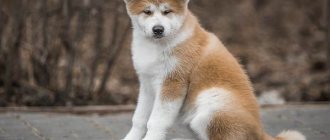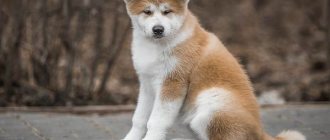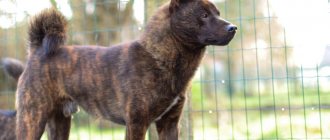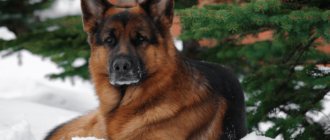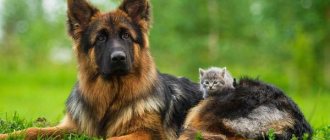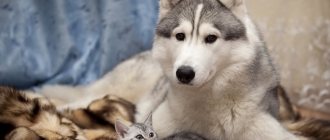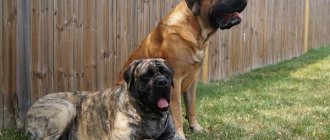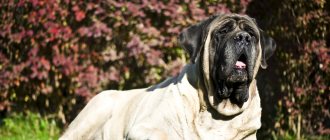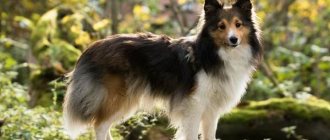Akita Inu is a dog breed recognized as a national treasure of Japan. The character of these large Spitz-shaped dogs harmoniously combines seemingly mutually exclusive qualities: good nature and alertness, courage and obedience. Over the centuries, they have proven themselves as universal hunters and reliable guards. In the modern world, they have become full-fledged members of families and reliable companions for their owners.
History of origin
Spitz-shaped Chinese dogs, considered the ancestors of modern Akita, appeared on the territory of the Japanese prefecture of the same name in the second millennium BC. e.
In the 6th century, clubs were formed in Japan aimed at preserving the hunting qualities of these dogs. Stud books with a description of the breed's main characteristics date back to the fifteenth century.
Due to the increasing popularity of dog fighting to increase size, starting in 1868, Akitas were crossed with Mastiffs as well as Tosa Inus, resulting in the loss of many of the characteristic Spitz traits.
At the beginning of the twentieth century, dog fighting was banned, but representatives of large Japanese dogs did not disappear, so the history of the Akita breed continues to the present day.
History of the breed
Akita Inu is one of the most famous Japanese Spitz dogs. It is one of the 14 most ancient dog breeds on earth. This version is confirmed by the results of archaeological research. DNA analysis showed the similarity of the Japanese Akita genotype with the genotype of wolves.
The homeland of this dog breed is considered to be the northern province of Hanshu Island, Akita Prefecture, a rugged mountainous region with a harsh climate. Winters there are cold and snowy. Large Spitz dogs were used to hunt bears, deer, and wild boars. As a rule, dogs worked in pairs - a male and a female. They drove the ferocious animals and held them until the hunters arrived. People in those days especially needed four-legged reliable helpers. In those days they were armed with bows and arrows. Any mistake during the hunt could lead to unpredictable consequences. It was reliable hunting dogs that protected people from the rage and revenge of wounded or enraged wild animals.
Local huskies already in those days established themselves as universal dogs. They moved silently and quickly. We moved well in deep snow. They had a keen sense of smell and a keen eye. They were distinguished by their endurance, intelligence and fearlessness in the hunt.
Initially, the dog was called “Matagi-ken”, then “Matagi-inu”. The ancient Japanese word "matagi" translates to "respected hunter." This is how in those days it was customary to address people who were considered the most successful hunters. This appeal was enshrined in the original name of the breed - “respected hunter dog.”
Initially, dogs stood out for their high intelligence and desire to help people. Red Spitz have proven themselves to be versatile dogs. There is evidence that indicates that these dogs helped fishermen drive fish into nets.
Documents show that already in the 6th century, clubs for breed lovers were founded in Japan. Dog handlers of that time developed recommendations that helped breed, maintain and train dogs. In the 15th century, special stud books were established. Pedigrees of dogs with nicknames and descriptions were carefully entered into them.
Experts attribute the final formation of the breed to the beginning of the 17th century. Kuge, who received the position of ruler of Akita Prefecture, was fond of hunting and dogs. He ordered his subjects to breed a new breed of large and intelligent hunting dogs. Set short deadlines. The breeders got to work. The blood of mastiffs and Tosa Inu was added to the local Spitz dogs. As a result of breeding work, the dog lost its Spitz features. But its representatives were superior to other local dogs in their large size and harmonious build. They stood out for their fearless character. At the same time, they retained excellent hunting qualities.
A new name was assigned to the dogs - Akita Inu. It is simply translated - “dogs from Akita Prefecture.”
Initially, these dogs were not available to ordinary people. Only aristocrats and members of the imperial family could own them. Dogs from Akita Prefecture, along with excellent hunting talents, showed remarkable guarding abilities. They reliably protected the palaces and houses of their owners.
Each dog was looked after by a separate servant dressed in a special expensive suit. The servant's clothing was supposed to emphasize the respect that the Akita Inu enjoyed. There were special ceremonies that were performed by staff when feeding and caring for the animal.
Special ammunition was made for the Inu. It was supposed to emphasize the rank of the dog and the social position of its owner.
From the Middle Ages until the beginning of the 20th century, one of the favorite entertainments of people in many countries of the world was dog fighting. It gained popularity in Japan in the 19th century. Akita Inu took part in them. It was only in 1908 that this bloody entertainment was banned in Japan. At that time, many experts assumed that this would lead to a decline in people’s interest in cynology and to the extinction of popular dog breeds, including the Akita Inu. They turned out to be wrong. Interest in the breed has not disappeared. It was preserved and developed. In 1931, in the land of the rising sun, the Akita Inu dog breed was recognized as a national treasure. From that moment on, the dogs were under state protection. It was prohibited to export them outside of Japan.
The situation changed during the Second World War. There was not enough food for the people. There was nothing to feed the dogs. German shepherds turned out to be more in demand in the country. They were used for the needs of the army. Breeders began mixing Akitas with representatives of this breed. Purebred Akitas were considered less valuable. Their skins were used to make warm clothes and shoes for military personnel.
At this time, a rabies epidemic broke out in the country. To protect people, a decision was made at the state level to exterminate all dogs that were not used by the army. As a result, only a few purebred representatives of the breed survived. Devoted followers of the breed smuggled them into mountainous, inaccessible areas of the country. This is the only way they have been preserved.
By the middle of the 20th century in Japan, all representatives of the breed could be divided into three types:
- hunting;
- fighting;
- service or mixed with a German Shepherd.
Japanese breeders have once again done a tremendous job to restore the breed.
At the same time, several purebred dogs were exported to the United States. American breeders used them as breeding material to breed the American type of Akita Inu. Subsequently, it was recognized as a separate breed, which was called the "large Japanese dog."
Description and characteristics of Akita Inu
The Akita Inu variety, informally known as the Japanese Laika or Husky, is a group of dogs characterized by a strong, muscular build.
Description of the Akita Inu standard:
| Part of the body | Characteristic |
| Head | Triangular with a wide forehead, proportional to the size of the body |
| Nose | Black, square shaped |
| Teeth | Strong, white with correct bite |
| Eyes | Dark brown almond-shaped with close-fitting eyelids, raised outer corners |
| Ears | Triangular, thick, slightly inclined towards the muzzle |
| Neck | Muscular, located at 45° to the horizontal, without skin folds |
| Back | Straight with sloping croup and wide loin |
| Rib cage | Voluminous with a noticeable keel |
| Front legs | Heavy straight with developed shoulders and powerful pasterns |
| Hind limbs | Strong with muscular thighs |
| Tail | Thick, rolled into a ring |
The description of the Akita Inu breed includes the characteristics of the coat, the peculiarity of which is the presence of three layers. The upper hairs are coarse and long. Beneath them is a harsh, shorter coat. The Akita's undercoat is soft and dense. White, red and brindle colors are allowed.
This dog has similar external characteristics to the miniature Shiba Inu, which is sometimes called a mini or dwarf Akita, but is a different breed.
Popular questions about the Akitu Inu breed
How many years do they live
The average life expectancy of an Akita Inu is 10-12 years. According to statistics, females live a little longer than males. This indicator may change in one direction or another. Much depends on the conditions of detention.
There is an opinion that in the 17-19 centuries they lived longer - 14-15 years. This fact is explained by various reasons. The main one is the nuclear bombing of Japan by the American military.
Who is suitable for Akita and Inu? What does an ideal dog owner look like?
The Japanese Akita dog fits perfectly into a large family with children. Can become a faithful companion for a lonely person. However, this will happen if several important conditions are met.
- A person should lead an active lifestyle. The dog needs physical exercise. Therefore, it is not suitable for elderly and lazy people. And also for those who suffer from diseases of the musculoskeletal system.
- Due to its leadership character, the Akita Inu dog is not recommended for weak-willed people and novice dog breeders - as a rule, they cannot cope with them. A calm and balanced person, confident in himself, will become a good owner for a Japanese dog.
How to treat children
Akitas love children. They make excellent nannies. They show inexhaustible patience towards their owner's children.
They never bite or show aggression. If the baby cries in the crib, they will not ignore it. They will draw the attention of parents to the “incident”. If they are not around, they will lick the child from head to toe and try to calm him down. Akitas consider it their duty to protect children. Strollers and cribs are protected. Under no circumstances will they allow a stranger to get close to the baby.
How does he get along with other animals?
The Japanese Akita dog calmly treats the dogs and cats with which it grew up, provided that they recognize it as the leader of the pack. Most likely he will not accept a new adult dog.
Shows aggression towards strange dogs of equal or larger size. The fighting past takes its toll.
Types of Akita Inu
After World War II, three varieties of Japanese Akita appeared:
- fighting;
- matagi;
- descendants of a cross with a German Shepherd.
Another type is the long-haired Akita Inu, which is distinguished by its large bone structure. Currently, such a sign as longer hairs on a dog’s tail, ears, and paws is considered a deviation from the standard.
The American Akita is also known as the result of the targeted activities of US breeders.
Character and intelligence
The main feature of the Akita Inu is considered to be nobility. These are good guards - calculating, brave, cold-blooded. They act quickly, correctly navigating the current situation. When other dogs appear on the territory, Akita Inus show aggression.
Puppies of this breed are distinguished by their curiosity and activity. Little Akita Inus are cheerful, always ready to play and love to get into mischief. With proper upbringing, dogs do not do dirty tricks.
Growing up Akita Inu pets are often characterized as cocky, but in a familiar home environment they behave quietly. In front of strangers, dogs show restraint and calmness.
Expert opinion
Anna Abramenko
An avid dog lover. Experience in veterinary medicine since 2009.
Ask a Question
It is not recommended to test the Akita's patience for a long time. The dog is capable of growling at overly annoying children who try to disturb it and use it as a horse.
The cheerful Akita Inu requires long walks. It must be taken into account that even with a strong attachment to the owner, these pets are distinguished by their independent character. Thanks to the willingness to participate in the games offered, the dog becomes a good friend.
The Akita Inu is not only suitable for families with children, but also ideally plays the role of a companion for single people.
Akita is considered a smart animal with developed intelligence. She will bring the leash if there is a need for walks. Akita Inu remembers instances of rough treatment for a long time.
Akita Inu does not like to be alone and rarely barks loudly. More often you can hear muffled snorting sounds from her, reminiscent of muttering. Akita Inu is a very curious pet, who will definitely check the contents of an abandoned bag and take shoes to a secluded corner.
Character
The representative of the breed fully corresponds to the “typical Japanese”. He absorbed all the character traits of a classic representative of the Eastern world. By temperament he is a mixture of melancholic and phlegmatic. Most often, calm, restrained in emotions. He is not prone to violent expressions of delight, but sometimes still demonstrates strong emotions to others.
Due to the presence of protective qualities, he is reserved with strangers. He treats most strangers without trust. Sees them as potential troublemakers for his family. He can openly express his antipathy to a person he doesn’t like, for example, come up and kick him with his nose, offering to move from his place. Yes, such a gesture may seem rude to many, but you shouldn’t get hung up on it.
Akita Inu is not evil by nature, on the contrary, it is a very kind dog. Around his family he is friendly and very affectionate. Loves to sit near the owner or walk with him. Does not tolerate separation, prefers never to be separated. It suffers and becomes melancholy if it does not see its owner for a long time. You may even lose your appetite because of this.
There is no activity for such a dog. He is active and playful. He loves to fetch a ball, run distances after it, swim in the river and just walk. If you cannot regularly take him to the forest for hunting or forays, we advise you to enjoy long walks. Even older people will not refuse to walk through the park.
Akita Inu prefer long, exciting walks for walks.
The representative of the breed has an interesting feature - he strives to base relationships with people on a strong emotional connection. Never ignores the person he loves. Can silently express sympathy for him, share joy, listen, etc. Perfect for providing psychological assistance. There is even a separate direction in psychotherapy (canistherapy), which consists of providing suffering people with help from their four-legged pets.
This dog has a clear desire for dominance, which is why it is not easy to train. You need to try to earn his trust. He will only be imbued with respect for a person with pronounced leadership potential. It is to him that he will serve faithfully for the rest of his life. He perceives everyone else as comrades and companions, but not his masters.
Gets along great with kids, especially very young ones. He watches them with interest and often shows responsibility. Protects and prevents children from being hurt. Can be used as a nanny. But you shouldn’t place too much hope on your pet in this regard!
Akita Inu's attitude towards cats is not as welcoming as towards children. He does not like these animals, and he also treats birds with distrust, and often with anger. Perhaps this is due to its guarding and hunting qualities.
Akita Inu is a very obedient dog breed and will be friends with all family members
But, if you raise such a dog together with other pets, then it is likely that they will become friends. Joint socialization always brings people closer together. This amazing breed is famous for having a strong will. No one can say that its representatives are stupid or weak in spirit. It is extremely difficult not to respect them.
Appearance
For the Akita Inu, the first standard was developed in 1938 and subsequently revised in 1955 and then in 2005. After the changes, spotted and black animals were excluded.
In terms of external characteristics, the Akita Inu is a calm, strong and large dog with pronounced signs of nobility in the interior and behavior.
Male Akitas at the withers reach a height of 64-70 cm and weigh 45-59 kg. In females, the height is 58-64 cm. The weight of an adult dog varies from 32 to 45 kg.
Maintenance and care
You can keep an Akita Inu in an enclosure, a private house or a city apartment. In indoor conditions, the Akita should have its own, secluded place.
Caring for an Akita Inu dog is not difficult, but requires regularity:
- Brush your Akita's thick coat once a week. During the molting period, this procedure is carried out daily, which avoids the appearance of a large number of hairs on carpets and furniture.
- Caring for and keeping an Akita Inu in an apartment involves bathing the pets no more than once every six months, except in cases where the fur becomes heavily soiled.
- Walking twice a day for more than 1.5 hours should be accompanied by active training sessions and games that help release large amounts of energy.
- Akita's claws are rarely trimmed, since with an active lifestyle they grind down on their own.
- The Akita Inu pet's teeth are examined three times a month, cleaning them with a special brush. Paste for this procedure can also be purchased at a pet store. Chew sticks can be used to prevent plaque and tartar formation by giving your dog once a week.
- To prevent the development of eye diseases in a dog, an annual visit to a veterinary ophthalmologist is required.
Expert opinion
Anna Abramenko
An avid dog lover. Experience in veterinary medicine since 2009.
Ask a Question
You need to take care of your pet's ears, cleaning them from dirt using cotton swabs at intervals of seven days. Avoid applying strong pressure so as not to injure delicate skin.
Diet and feeding
When organizing a daily menu for your dog, you should take into account that Akita Inu is capable of gaining excess weight. Therefore, along with sufficient physical activity, she is provided with a balanced diet.
It is considered the most rational to include professional food in the Akita Inu menu. When selecting them, pay attention to the age of the pet. It is mandatory to constantly have fresh water for the dog.
Adherents of a natural diet should select a variety of foods for their Akita Inu. Along with low-fat varieties of fish and meat, which make up half of the daily volume, you will need cereals, fermented milk products, and vegetables. Eggs are given two per week.
Vitamin supplements are used on the recommendation of a veterinarian. Akita Inu are prohibited from sweets, flour and potato products, and bones. For an adult dog, two meals a day are prescribed.
You can evaluate the development of an Akita using a table reflecting standard changes in size as it grows older:
| Age, in months | Weight, kg | Height at withers, cm |
| 6 | 21 | 56 |
| 10 | 25 | 62 |
| 12 | 30 | 64 |
| 24 | 40 | 70 |
Upbringing
The Akita Inu dog has pronounced willfulness, independence and requires endurance and a lot of time from the owner for training.
The main method is an attentive, affectionate attitude towards the dog with an acceptable degree of severity, since proud pets do not tolerate cruelty, remembering it for a long time.
Akita Inu training begins immediately after the puppy appears in the house. He must learn the rules of behavior in different situations and at the same time feel that all household members are friendly towards him.
Possible diseases and methods of treating them
Akita Inus are healthy and cheerful dogs. Unfortunately, they are often bothered by parasites, especially fleas. This primarily applies to individuals living on the street. To prevent your pet from encountering the problem of parasites, treat its fur with special drops or spray.
It is important to follow the instructions. It would also be a good idea to consult a doctor about deworming medications for your dog. Due to the abuse of natural food, his digestion may be upset. In this case, diet and gradual normalization of the diet will help.
Health, possible problems and treatment
An Akita Inu dog, despite its strong build and rather large size, may require the help of a veterinarian if a number of characteristic pathologies develop:
| Disease | Signs | Causes | Treatment methods |
| Hip dysplasia | Severe pain. Possibility of loss of ability to move | Genetic predisposition, unbalanced diet, bruises | Surgical or drug treatment when the first symptoms appear |
| Entropion of the eyelids | Unnatural turning of the edge outward or in the other direction | Hereditary factor | Removal by surgery |
| Hypothyroidism - thyroid dysfunction | Skin diseases, apathy, hair loss | Passed on from parents or manifested as a complication after previous infections | Prescribing hormone therapy |
| Volvulus | Vomiting, bloating, loss of strength | Lack of activity, overeating | Surgical treatment. As a preventive measure, they practice soaking dry food, organizing more frequent meals in small portions, and additional physical activity. |
Sometimes Akita Inu exhibit eye pathologies such as cataracts and retinal dysplasia. Immune malfunctions, tumors of the sebaceous glands, and von Willebrand disease, characterized by blood clotting disorders, may develop.
Expert opinion
Anna Abramenko
An avid dog lover. Experience in veterinary medicine since 2009.
Ask a Question
To ensure the good health of Akita Inu dogs, vaccinations are mandatory and must be carried out in strict accordance with the schedule developed by the veterinarian.
Akita character
Friendly, energetic, cheerful dog with high intelligence.
Brave. He has an independent and proud character. Always ready to fight for leadership and championship. In the family he strives to take a dominant position.
An Akita dog is understanding and pleasant in communication with its owner if there is mutual understanding. If it is not there, the pets begin to show stubbornness and disobedience.
The Japanese Husky is unobtrusive and delicate by nature. It will never bother the owner if he is busy with business. On a day off, he won’t get him out of bed early in the morning. He will wait until he wakes up and is free. At the same time, she always tries to stay close to him.
Although the appearance of the Akita suggests that he does not care about the opinions of others, this is not the case. Needs emotional contact with the owner. If he doesn't pay enough attention, he may get offended.
Akita loves all family members. Treats their relatives and friends well. Enjoys communicating with people. But on one condition. Respect must be mutual. People should reciprocate his feelings.
He is wary of strangers. Always vigilant. If a stranger seems suspicious, he will not immediately attack him. It will make a menacing roar. Will try to scare away the attacker.
The Japanese Spitz is the type of guard who easily lets a thief into the house, but will never let him back out before the owners arrive.
When describing the character of the Akita Inu, experts often use the epithet “loyal.” In ancient times, Japanese mothers, when leaving home, left their children in the care of Akita Inu dogs. Despite his restraint in expressing his feelings, the dog is loyal to his owner and family. He will always stand to the last, protecting his loved ones.
Akita Inu is a one-owner dog. When for some reason an adult dog is given to a new family, it takes a long time for him to get used to the new owner. And such an “experiment” does not always end in success. Often these dogs simply run away. Therefore, before you take such a puppy into your home, soberly assess your capabilities.
Barks rarely and only if there is a reason. However, these dogs can be called talkative. They express their emotions with special grumbling, snorting and howling.
Akita dogs are not always aware of the dangers of heights. They may jump out the window or from the balcony if they see something interesting on the street.
Pros and cons of the breed
Among the advantages of Akita Inu dogs, the following characteristics stand out:
- fearlessness;
- reliable protection of the home and the whole family;
- friendliness;
- equilibrium;
- devotion;
- cheerfulness;
- high intelligence;
- cleanliness;
- stress resistance;
- possibility of living in different conditions;
- rare loud barking.
There are also some disadvantages:
- the difficulty of training;
- display of aggressiveness towards other dogs;
- rancor.
By analyzing the pros and cons of the Akita, you can make sure that the positive character traits of these amazing pets predominate.
Hachiko's story. Fiction or truth
The whole world learned about who Hachiko was thanks to cinema. People cried when watching films about a faithful dog. Two of them were filmed. In 1987, the Japanese film The Story of Hachiko was released. In 2000, the Americans filmed a remake of it, “Hachiko: The Most Faithful Friend.” The role of the professor in it was played by Richard Gere. It was the second option that most Russians looked at. People were not only touched by the tragic fate of the Akita Inu, they wanted to know the true story of the legendary dog. In the American version, events developed in the USA. The story actually took place in Japan in Akita Prefecture.
The real Hachiko was born on November 10, 1923. He was the eighth dog in the life of the Japanese scientist Hidesaburo Ueno. That's why he named his pet Hachiko. Translated from Japanese as “eighth”. There is another meaning for this word - “devotion”. Some experts argue that the nickname given to an animal affects its fate. Not everyone agrees with this statement. However, the fate of Hachiko is a clear confirmation of this.
The dog has grown up. Every morning he accompanied his master to Shibuya Station, from where he left for work in Tokyo. Hidesaburo Ueno taught at the capital's university. The dog was returning home. By three o'clock in the afternoon I returned to the station again. I met the professor.
On May 21, 1925, the irreparable happened. At work, during a lecture, the professor had a stroke. Those around him were unable to provide him with the necessary help. Ueno died.
At that time, Hachiko was one and a half years old. That day, as usual, he arrived at the station at three o'clock in the afternoon. I waited until evening. To no avail.
The next day, at three o'clock in the afternoon, the dog again came to meet the train. History repeated itself day after day. Hachiko did not lose hope. He hoped that his loving owner would return one day. The dog spent the night on the porch of the owner's house. Relatives and friends tried to take the dog home. The dog didn't want this. At the first opportunity, I ran away from them and returned to the station. Local merchants and railroad workers fed him out of pity. So seven years passed.
One of the professor's students wrote an article about an old and faithful Akita Inu, who has been waiting for many years for the return of his deceased owner, and published it in a major Tokyo newspaper. The story shocked Japan.
People flocked to Shibuya Station, where the events unfolded. They came only to see the devoted dog with their own eyes. Some dreamed of taking Hachiko with them. However, they failed to do this. The dog did not pay attention to them, did not make contact, did not accept the affection of strangers, and continued to live according to his own schedule.
The loyalty and devotion that the dog kept towards the deceased person aroused respect and admiration. People decided to erect a monument to the legendary Akito Inu. The opening ceremony took place on April 21, 1934. At that time, Hachiko was still alive. According to eyewitnesses, the dog himself was present at the event and indifferently contemplated what was happening.
In 1935, Hachiko died. It happened on the street adjacent to the station. As an autopsy later showed, the cause of death was heart disease, which had begun to progress to cancer. By that time, the dog had already become a four-legged hero throughout the country. National mourning was declared over his death.
Some of the remains of the faithful dog are buried in Tokyo's Aoyama Cemetery, the other is stuffed in the capital's Science Museum.
During the Second World War, the monument to the faithful Akita Inu was dismantled for military purposes. The country needed metal. After the war, in August 1948, it was restored at the request of the people.
Flowers are brought to the statue of the legendary dog, located on the pedestal. Lovers make dates near her. Tourists take pictures. For the Japanese, the Akito Inu Hachiko remains a symbol of fidelity and love.
In 2015, a second monument to the legendary dog was opened at the University of Tokyo. Its official name is “Statue of Hachiko and Dr. Hidesaburo Ueno.” However, residents of the capital call it differently - reunion.
The sculptor captured the moment Hachiko met her owner. Hachiko dreamed about this event for nine long years. I didn’t wait in my lifetime. People have united a faithful dog and its owner in bronze.
Which nicknames are more suitable?
Distinguished by its aristocratic habits and excellent appearance, the Japanese Akita Inu dog breed requires the selection of appropriate nicknames for its representatives.
Akita for boys
When purchasing Akita Inu puppies from nurseries, you can get recommendations on what to name them.
There are many options, among which the following nicknames sound harmonious for noble young male Akita Inu:
Amigo, Amethyst, Aristocrat, Atilla, Buddy, Banderos, Blade, Vincent, Valient, Helios, Gold, Daymond, Darchi, Dex, Zlat, Zordan, Emperor, Calypso, Leo, Mulder, Mathis, Osiris, Patzk, Simon, Urmas, Ursus, Hunter.
Given the poise and amazing intelligence of their cute furry friend, many turn to the Japanese language to find the appropriate symbol for the puppy's name:
| Sounds in Japanese | Russian translation |
| Akio | Handsome |
| Akayo | Smart |
| Aiken | Favorite dog |
| Avayuki | Light snow |
| Busi | Warrior |
| Biso | Ancestor |
| Daitore | The president |
| Dike | Your Honor |
| Eko | sunlight |
| Oji | Prince |
| Daitan | Brave |
| Akarui | Funny |
| Adappoy | Charming |
| Baisei | Satellite |
| Shinju | Pearl |
| Vakari | Understanding |
| Gekan | Emperor's sword |
| Daitensai | Great genius |
| Dzai | Wealth |
| Yezakari | Dawn |
| Daigan | Heart's desire |
| Yesimi | Friendship |
Akita for girls
Japanese poetry can be a source for choosing a beautiful nickname for a young female Akita Inu:
| Sounds in Japanese | Russian translation |
| Akemi | Vibrant beauty |
| Ibara | Rose |
| Ayako | Smart girl |
| Marie | Darling |
| Kazuko | Harmonious |
| Kazari | Decoration |
| Mizeki | beauty flower |
| Mezumi | Perfect |
| Tekera | Treasure |
| Hoshi | Star |
| Cho | Butterfly |
| Ayaka | Flower |
| Akane | Brilliant |
| Yoko | Confident |
| Kiku | Chrysanthemum |
| Kay | Respectful |
| Papetto | Doll |
| Mizuki | beautiful moon |
| Medoca | Calm |
| Seyeri | Little lily |
| Shinju | Pearl |
| Yuki | Happiness |
Puppy selection criteria
Having decided to purchase a dog of the unique Akita Inu breed, you need to pay attention to the following signs:
- the ears of even small Akita Inu puppies are characterized by proportional sizes compared to the head;
- the dog’s skeleton, which can be felt by light palpation, is distinguished by large and dense bones;
- the fur on the pet’s hips has a more rigid structure than on other parts of the body;
- the color of the undercoat of the mask on the Akita Inu's muzzle first has a gray tint, acquiring a characteristic whiteness by six months;
- Akita puppies are constantly in play, characterized by incredible mobility and curiosity.
The breeder is obliged to provide the necessary documents of the dog with a pedigree. It must be taken into account that young animals are put up for sale from the age of two months.
Interesting Facts
In its homeland, the Akita is a cult dog. She is considered an excellent companion, protector of the home, and a symbol of good health. There is a tradition, when a child is born in a family, to give the parents a figurine of an Akita. Such a gift symbolizes the wish of happiness, health and longevity. A person receives the same souvenir if he is very sick. Friends and relatives express their support for him in this way and wish him a speedy recovery.
The Japanese Akita is one of the world's most popular dog breeds used as companions. She competes with Labradors for the title of “best companion.” In the USA, these balanced, friendly dogs are specially trained and used in medical centers for the rehabilitation of people who have suffered serious illnesses or are struggling with serious illnesses. Akitas provide convalescents with emotional support in the fight against the disease. They are used for the same purpose in nursing homes.
If you look at an Akita Inu, the dog may appear to be smiling. The point is the special structure of the jaws.
On the Akita's paws, the toes are pressed tightly together. It's like they grow together. Due to this, it seems that they are connected by membranes. The special structure of the paw allows the dog to correctly distribute its weight so that it can easily move through the snow. For the same reason, Japanese dogs feel great in water - they swim well.
In 1977, the Akita Inu Museum was established in Odate, Japan. The exhibits presented there tell the history of the breed. The office of the Society for the Protection and Preservation of Akita Inu is located in the same city. This organization annually holds breed championships and selects the best representatives.
In 2012, Akita Prefecture Governor Norihisa Satake presented an Akita Inu puppy to Russian President Vladimir Putin. The gift was presented as a token of gratitude for Russian assistance in eliminating the consequences of the 2011 earthquake. The puppy was given the name Yume. Translated from Japanese into Russian as “dream”.
Where to buy and cost
The Japanese Akita Inu dog breed is one of the most expensive pets.
To purchase dogs of this breed, it is advisable to contact reliable kennels with a good reputation. It is taken into account that the average cost of an Akita Inu in Russia, calculated in rubles, varies from 40 to 70 thousand.
Some people prefer to attend fairs and exhibitions. It should be noted that the prices of Akita Inu puppies in such an environment can be even higher, reaching 170 thousand rubles.
Nutrition
Make sure your dog does not gain excess weight. Being overweight is fraught with impaired digestive function, body asymmetry and poor health. For an adult representative of the breed in question, the daily dose of food is 600 grams. Give him the opportunity to eat twice a day, for example at 9 am and in the evening, closer to sunset.
The younger the dog, the more protein it should consume daily. Feed her dairy products, raw meat and cereals boiled with vegetables. It is advisable to add special vitamins to your dog’s food. We recommend that you consult your veterinarian first. He himself will select the supplement your pet needs.
Advice! The best complementary food for purebred dogs is bone meal. This is a very useful product, the use of which will significantly improve their health.
Akita Inu puppies , like adult representatives of the breed, can eat dry food. But, it is advisable to dilute their diet with natural food. Recommended products: cottage cheese, chicken eggs, turkey, buckwheat, bananas, etc. But you can’t give them smoked meats and dishes with spices.
Reviews
Olga, 25 years old. Nizhny Novgorod: “My daughter persuaded me to buy an Akita Inu puppy. We purchased a pet from a Moscow nursery. We were given a passport and provided with information about the dog’s vaccinations. Despite his two-month age, the furry miracle won all the hearts of our relatives with his cheerful disposition. The dog was accustomed to professional food, so there were no problems with nutrition. We agreed with a dog handler regarding Akita Inu training.”
Natalya, 33 years old. Cherkessk: “I was given a three-month-old Akita Inu puppy for my birthday. The dog immediately showed its activity and independence. I had to take all my shoes away from her. I started taking my dog to professionals for training because I didn’t have the patience myself. But overall it is an incredibly sweet and loving animal that needs two very long, active walks every day.”
Elena, 40 years old. Ivanovo region: “Our Japanese Akita is 3 years old. This is a smart, clean, self-controlled dog that is a pleasure to walk with. At home, the Akita Inu loves to be around people. The dog quickly found mutual understanding with the cat and plays with the children. But Akita cannot tolerate the slightest rudeness, so we treat her strictly, but kindly.”
Reproduction and lifespan
The lifespan of an Akita Inu depends entirely on how conscientiously the owners take care of it. A dog can live a long and happy life, but only if it is, firstly, fed properly, secondly, given vitamins to improve the condition of the coat and strengthen the immune system, and thirdly, if you regularly exercise with it .
Average life expectancy is 13 years. It is easy for a breeder of this breed to distinguish it from any other, because the Akita Inu has a unique, distinctive appearance. Dogs are bred on neutral territory and only during the female's menstrual period. If conception is successful, she will go into labor approximately 70 days after mating with the male dog. It is advisable to invite a veterinarian to the birth process.
Photo and video of a pet
A variety of video materials will help you more fully visualize the external and behavioral advantages of the Akita in various situations. You can form your own impression of the unique Akita Inu breed from the photo.
